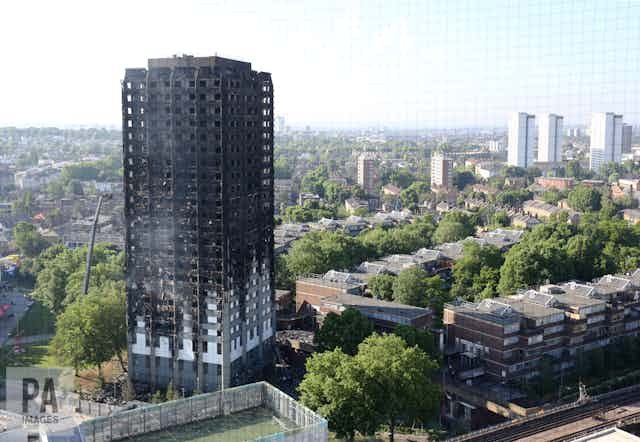Since YouTube invited us to “broadcast yourself” in 2005, the means and methods to do so have increased exponentially. The rise of accessible digital technologies along with multiple social media platforms such as Twitter, Facebook and Instagram have become key to everyday popular communication. Such platforms also enable users to develop a social and political visibility by attracting attention to events and social groups who may be subject to a system of violence that is not always visible.
The Grenfell Tower disaster is one such example of an invisible violence that only came into view as a result of a tragedy. While newspapers were quick to frame the event as Theresa May’s Hurricane Katrina moment, the housing block, located in the affluent West London Royal Borough of Kensington and Chelsea, has become a focal point of discussion related to seldom discussed issues of class subjugation in the UK.
But the Grenfell Tower residents are also burdened with this representation. Stuck in a visual trap that offers little economy, the Grenfell residents have been subject to a host of visual regimes that have varied from exclusion, invisibility, hyper-visibility, before most recently becoming the subjects of dark tourism. It is only when a disaster like this happens that a community and its problems are truly rendered visible.
From anti-occupation protesters in the West Bank to Black Lives Matter activists in the US, the tactical deployment of social media can offer what political theorist Hannah Arendt has referred to as a “space of appearance”, whereby an opportunity arises, often through the action of a community otherwise ignored or excluded politically, to be heard and seen. Such affordances enable those without representation to participate and manage their claim for rights and justice. Such “appearances”, through protest or otherwise, can at times produce narratives that run counter to the “reality” afforded to us by conventional media coverage.
Caught off guard
For the residents of Grenfell, this was perhaps most notable when a nine minute video appeared of local resident and #Justice4Grenfell campaign organiser, Ishmael Blagrove, was posted speaking angrily to a Sky News reporter seeking a human interest feature.
Posted on YouTube by the user Jiminy Cricket on June 16 2017 and filmed on the streets next to the tower, the nine-minute clip captures Blagrove upbraiding the reporter, saying:
You are the ones who facilitate this. You are the mouthpiece of this government. You are the people who make this possible. You are the ones who validate it. You are just as culpable.
Blagrove adds that the “government didn’t see the community” and “were too concerned with the aesthetics of the building” rather than “the safety of those inside”. Referencing the 2014 renovation of the towers façade, Blagrove’s comments draw attention to how those on the margins of society are often rendered voiceless by a system that recognises their presence but also renders them invisible.
With more than 248,000 views on YouTube, an edited four-minute version has been accessed over 2.7m times on just The Deep Left Community Group Facebook page with an additional, shorter version on the same page totting up 60,000 views. These figures demonstrate how grassroots media and narrowcasting, such as vlogging and live broadcasting with basic technologies, to large audiences are challenging the media to significant effect. This is perhaps best evidenced when the Sky reporter asks Blagrove if he can film him, only to be told (pointing to the numerous phones on show) that “it’s already being filmed”, adding: “The mainstream media has dropped the ball.”
Dropping the ball
With “the ball” no longer exclusively in the hands of the major media outlets, the video of Blagrove identifies how social media is being used to disrupt the “slice of reality” concept offered by traditional news broadcasting. Social media has widened the Grenfell discussion beyond a human catastrophe to issues of austerity politics and acts of social marginalisation.
A timely occurrence, the exchange reflected a bitterly held belief that the media is beholden to the rich, the powerful and the right-wing, in addition to the near-consensus among reporters that Jeremy Corbyn was unelectable, the video “exposes” otherwise unheard truths. In doing so, the video demonstrated how social media can make it, as sociologist John Thompson has shown, “more difficult for political actors to throw a veil of secrecy around their activities” and “harder to control the images and information that appear in the public domain”. It also gave a presentness to proceedings, a real, unedited moment that has now become a record in the online archive.
Immediacy vs reality
Blagrove’s speech is one of frustration and pain. A frustration with an assumption that as a community of sufferers, they are also entering, wilfully or otherwise, into a social contract whereby “outsiders” can momentarily tell their story in a specific way “for them”.
While social media can offer a “space” in which those without recognition or voice can appear, we should also not be overly optimistic. While Blagrove’s video is about performance and seizing upon an opportunity, a quick search of YouTube offers hundreds of individually uploaded videos that carry a similar message but with little to no views. And so we should be cautious about the emancipatory potential of such technologies.
Eight weeks on, the video is still online and still as powerful as it was when it was first published, but little has changed. Goodwill gestures from pop star, Adele, promises of public inquiries and nationwide testing of similarly clad tower blocks are short term responses to long term problems.
So what next? What should we expect from the socially engaged activists in and around Grenfell? We only have to look at the success of #BlackLivesMatter to understand the potential for social media to circumvent or challenge mainstream media. It will depend on how the story unfolds – and who takes control of it.

